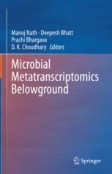Search
Search Results
-
Chemical Signal Dissemination Through Infochemicals
Every species has its own way of communication with diverse range of complexity that is relatively simplified in case of higher organisms while...
-
Grazer-Induced Chemical Defense in a Microcystin-Producing Microcystis aeruginosa (Cyanobacteria) Exposed to Daphnia gessneri Infochemicals
Cyanobacteria are photosynthetic microorganisms that compose phytoplankton and therefore have a trophic relationship with zooplankton, which...

-
Flavonoid Infochemicals: Unravelling Insights of Rhizomicrobiome Interactions
Root exudation consists of several biochemicals which act as the modifier of rhizospheric ecosystem favouring plant growth and development. These...
-
Algal blooms in the ocean: hot spots for chemically mediated microbial interactions
The cycling of major nutrients in the ocean is affected by large-scale phytoplankton blooms, which are hot spots of microbial life. Diverse microbial...

-
Long-term continuous mismatch between grazing cues and real grazing losses causes attenuation of induced morphological defense in Scenedesmus
For the freshwater phytoplankton Scenedesmus , morphological defense induced by infochemicals released from grazers (such as Daphnia ) is considered to...

-
Functional Diversity of Infochemicals in Agri-Ecological Networks
The trophic info networks are ecological networks through which information flows from one trophic level to the other. They are like food webs, but...
-
Chemical ecology of triatomines: current knowledge and implications for Chagas disease vector management
Triatomines (Hemiptera: Heteroptera: Reduviidae), commonly known as conenose or kissing bugs, includes species of outstanding medical importance...

-
Immune Stimulation via Wounding Alters Chemical Profiles of Adult Tribolium castaneum
Group-living individuals experience immense risk of disease transmission and parasite infection. In social and in some non-social insects, disease...

-
An Ocean of Signals: Intracellular and Extracellular Signaling in Diatoms
Diatoms are frequently exposed to diverse biotic and abiotic stressors, and they rely on sophisticated sensing mechanisms to perceive and respond...
-
Lipid mediators in marine diatoms
Diatoms are eukaryotic microalgae representing one of the major groups in the marine phytoplankton, accounting for up to 40% of annual productivity...

-
Indirect effects of invasive and native predatory copepods (Mesocyclops pehpeiensis Hu and M. longisetus curvatus Dussart) on the population growth of brachionid rotifers
We quantified the effect of two cyclopoids, an invasive ( Mesocyclops pehpeiensis ) and a native ( Mesocyclops longisetus curvatus ) species on the...

-
Chemical Mediation of Oviposition by Anopheles Mosquitoes: a Push-Pull System Driven by Volatiles Associated with Larval Stages
The oviposition behavior of mosquitoes is mediated by chemical cues. In the malaria mosquito Anopheles gambiae , conspecific larvae produce...

-
The Diatom Microbiome: New Perspectives for Diatom-Bacteria Symbioses
Since their relatively recent evolution, diatoms have come to dominate today’s oceans, playing a critical role in major biogeochemical cycles,...
-
Aquatic chemical ecology meets ecotoxicology
Chemical ecology and ecotoxicology are research directions that emerged between the 1950s and 1970s following a rise in awareness for info- or...

-
Do omnivorous black bullhead (Ameiurus melas) and planktivorous common bleak (Alburnus alburnus) elicit different inducible defences in Daphnia magna?
The aim of this study was to explore whether the widespread zooplankter Daphnia magna is able to differentiate between the kairomones of...

-
Allelopathic effects of male and female calanoids and cyclopoids (Copepoda) on the demographic response of Brachionus havanaensis (Rotifera)
We hypothesized that cyclopoids, being predators, have a stronger allelopathic influence than calanoids on life-history variables of herbivorous...

-
An Overview of Fungal Volatile Organic Compounds (VOCs)
Fungi emit many volatile organic compounds (VOCs) as mixtures of low molecular mass alcohols, aldehydes, esters, terpenoids, thiols, and other small...
-
Ciliate Grazing on the Bloom-Forming Microalga Gonyostomum semen
The freshwater raphidophyte Gonyostomum semen forms extensive summer blooms in northern European humic lakes. The development of these blooms might...

-
Specific Response of Bacterial Cells to the Action of β-Ionone
AbstractThe biological activity and mechanisms of action of the unsaturated ketone β-ionone, a volatile compound of serious interest for...

